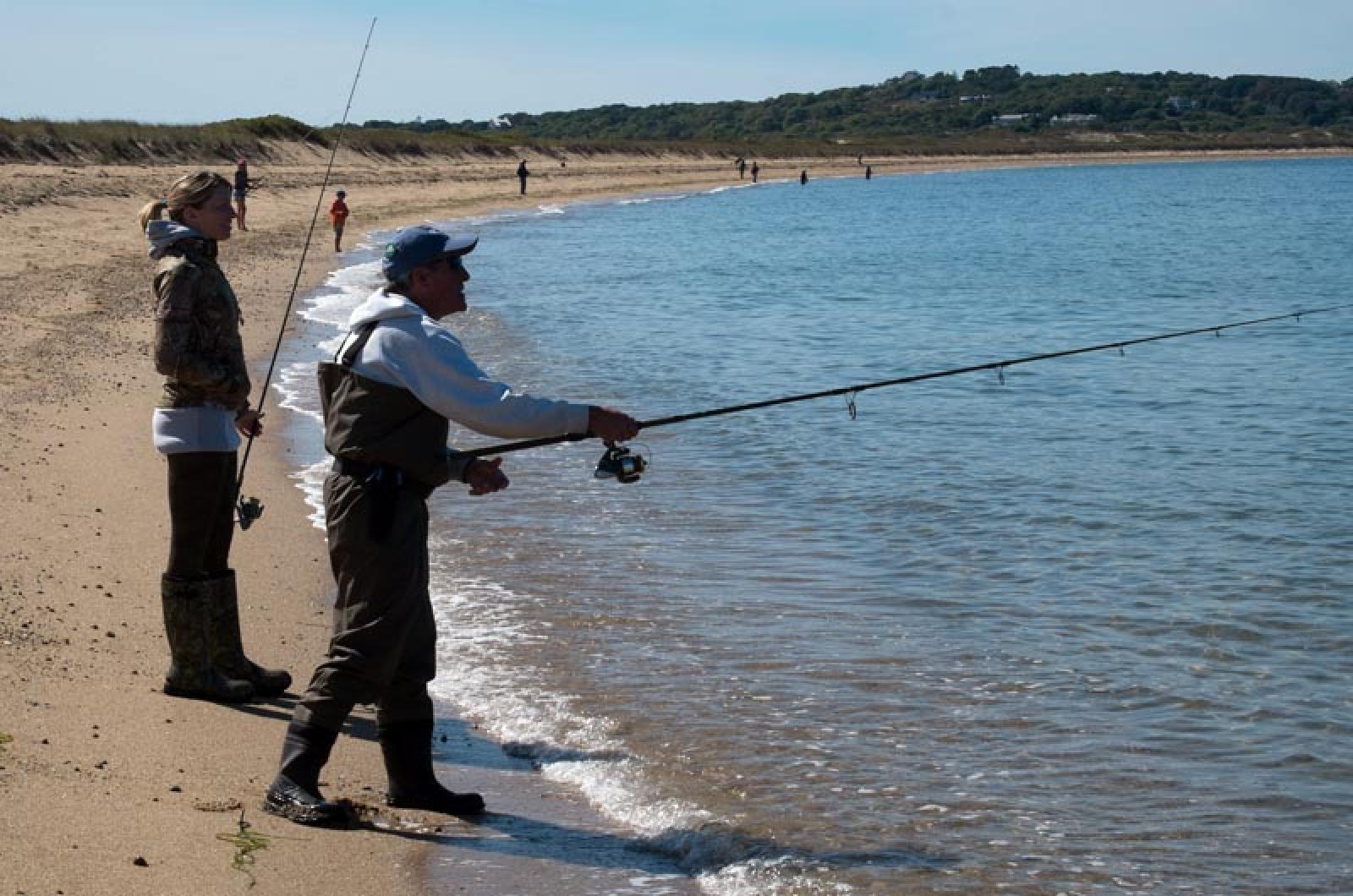By all accounts, the 69th Martha’s Vineyard Striped Bass and Bluefish Derby was a major success. A record number of fishermen weighed in 2,305 fish, including 520 false albacore (the most since 2004), 551 Atlantic bonito (the most since 1994) and 946 bluefish, which was slightly more than last year’s catch.
But the number of striped bass was dramatically lower this year, with only 288 weighed in over four weeks — more than 40 per cent fewer than last year, and the lowest count since 1996. Greg Skomal, a former Vineyard resident who is now a senior biologist with the state Division of Marine Fisheries, said the dwindling number of striped bass in the derby in recent years reflects a more general decline in the population since 2004.
The Atlantic States Marine Fisheries Commission is developing new regulations to help increase the population and expects to present a final proposal next week. It will likely include new size and catch limits, along with new commercial quotas, with the goal of reducing juvenile mortality by around 25 per cent.
When the striped bass population collapsed in the 1980s due to overfishing and other environmental factors, the ASMFC responded aggressively with new regulations that helped lead to a rebound in the 1990s.
Stripers were removed from the derby altogether between 1985 and 1992, a measure that derby president Ed Jerome said was mostly symbolic. Stripers were gradually reintroduced to the derby, and between 1997 and 2007 their numbers fluctuated between about 600 to 800 per year.
In contrast to the derby numbers, the state’s recreational catch of striped bass in 2013 was about 4.8 million pounds. Another million pounds were harvested commercially. The new regulations could potentially cut the recreational catch limit in half, Mr. Jerome said. “What they are planning to do is monumental.”
Mike Waine, fisheries plan coordinator for the ASMFC, conducted 19 public hearings this year between North Carolina and Maine — including on Nantucket and the Cape — to help guide the new regulations. He said many fishermen along the coast were not seeing as many striped bass on the water as they did in the mid 2000s. On a brighter note, the Maryland Department of Natural Resources reported this week that its juvenile index (the average number of juvenile striped bass surveyed in the summer and early fall) was only slightly below the 61-year average of 11.7.
The so-called young-of-the-year index has been below average for four of the past five years, although 2011 had one of the highest counts on record. Mr. Skomal joined the derby committee around 1992. Over several years he served terms as president, treasurer and secretary, and is now an advisor. He said the coast-wide data for recreational fishing in 2014 was still being collected, so it was unclear whether the low numbers in the derby reflected a wider decline during the year.
In recent years, derby contestants have been weighing in smaller fish, which he said was likely an indication of fewer large fish in the population. They also are catching more striped bass from the shore, where the younger, smaller fish tend to feed. Shore catches in the derby have averaged about 45 per cent since 1993, but jumped to 68 per cent in 2012. This year 55 per cent of the striped bass were caught from shore.

Gary Nelson, fish biology program manager at the DMF, said most striped bass in general are caught from boats. He said the recent decline in the number of spawning females and larger adults was partly due to the low survival rate of young fish in Chesapeake Bay (a major spawning ground) between 2004 and 2010. “Some of us think it was due to weather patterns that were happening down in Chesapeake Bay at the time,” he said.
He said the derby itself is not a very useful indicator of the wider striped bass population, since information on how long an angler was fishing and other factors are usually not reported. “Just bringing back the fish that they picked out that was the biggest, it’s kind of hard to use that information,” he said.
But he agreed that the trend in the derby over the years was likely a reflection of the wider striped bass population. “The catch rates in recreational fisheries tend to correspond with what the population is doing,” he said. In the past, he said, the Vineyard derby and Massachusetts Saltwater Fishing Derby showed similar trends.
The coast-wide striped bass population is managed through minimum size limits, but each state has its own approach. In Massachusetts a striped bass must be at least 28 inches long to be harvested, and there is no upper limit. The daily recreational harvest is also limited to two per person, and only hook-and-line fishing is allowed. Most of the ASMFC proposals include higher minimum size limits to help protect the larger spawning females.
The derby has its own minimum sizes for all four species in the contest, including 32 inches for striped bass. That number has changed over the years, but has remained above the state limit.
“We have always made sure that the derby is much, much higher than the state in size limit, so you are not catching an abnormally large number of fish,” Mr. Jerome said. He said the derby committee evaluates its size requirements every year. “There is always a discussion over every one of the fish, not just the striped bass,” he said. “We look at each situation.”
Fish populations in general can increase and decrease dramatically, he said. He pointed out that anglers have been concerned about Atlantic bonito, which saw a dramatic decline in 1994, but that this year’s derby catch was surprisingly high. Weakfish were permanently removed from the derby in the 1990s.
Mr. Skomal agreed that the derby was just a drop in the bucket compared to the total coast-wide harvest. “But at the same time, the derby’s philosophical approach has been one that teaches the youth and teaches the community that there is no need to kill small fish,” he said. “And I think that’s been a very good approach.” He said the derby is as much about education and conservation as it is about competition.
Mr. Jerome said it was too early to know how the new regulations would influence the derby rules. But he said that another moratorium would also be symbolic. “I don’t think anybody is going to [take action] until they find out what the state is going to do,” he said.







Comments
Comment policy »